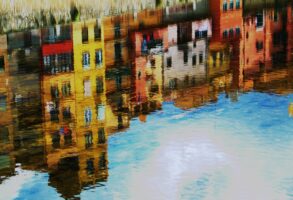Published December 31, 2016
The New Criterion - December 2016 issue
Since they began opening their doors to the public toward the end of the eighteenth century, art museums have been repositories of superior art. They have attempted to separate the wheat from the chaff, the permanent and profound from the inferior and transient. They display objects judged by the eye of history to be the most important of the civilizations that produced them. They have been places where visitors view art of the highest order, sanctuaries that offer enlightenment, inspiration, wisdom, and solace, far from the hurly burly of daily life.
But beginning in the 1960s, the idea of museums as sentinels of excellence, education, and expertise was challenged as antiquated, elitist, and just plain wrong. In the last several decades, this postmodern trend toward cultural relativism has accelerated alarmingly.
There are, as we shall see, ongoing attempts to abandon curatorial authority, and quality, in order to turn museums into something between a town hall and a community center. And, amazingly, directors and curators themselves are leading these efforts. Quis custodiet ipsos custodes?
Museums have long encouraged curators outside their institution to plan or collaborate on exhibitions, but traditionally these have been qualified people with the necessary training and experience to do so. But now, individuals without these credentials are being urged to share, or make, important decisions that affect the very nature of these places. It’s a little like asking someone who has never played the game to referee a tennis match.
This is nowhere better seen than at the Indianapolis Museum of Art. Last year, the museum launched an online survey describing six possible exhibitions. It asked respondents: “Based on the description above, how likely would you be to visit the IMA to view this exhibition?”
Among the six were: “The Art of Forgery,” “Japanese Paintings,” “The Rise of Robotics,” “Hot Cars, High Fashion, Cool Stuff,” and “Orchids.”
By conducting the survey, the museum invited everyone with an internet connection, whether museum members, visitors, or anyone who just wanted to offer an opinion, to weigh in on what sorts of exhibitions were worthy of support and production.
Now, it is quite possible that some of the respondents had deep pockets of knowledge about art and museums, but it’s more likely that the vote was less informed, really only a popularity contest.
The results of the survey have not been released, but I’d bet on hot cars and cool stuff or robotics over Japanese paintings.
In another attempt to involve the community in some of its curatorial decisions, the museum established an Office of Art Grievances. Managed by the museum’s Public Projects team, it provides “a system for the public to formally file a complaint against ‘Art,’ either ‘generally or specifically.’ ”
Complaints are sent to the Orwellian-sounding Office of Art Resolutions, “where an official will attempt to remedy the art-related issue.” The purpose of the office is to produce “a feedback loop between audience and institution,” creating “an opportunity to examine the things about art that cause us distress and angst.”
Whether this “feedback loop” directly influences decisions about which works the museum hangs or what sort of exhibitions it mounts is unclear, but one can be fairly certain that it will cause curators to think twice about displaying an object that has a rap sheet.
And will the museum begin to think about its galleries as “safe spaces” devoid of micro-aggressions that might, in some way, cause angst to its visitors? (It’s hard not to believe that all of this is a hoax, but there is a page on the museum’s website describing the office and its responsibilities.)
***
By subcontracting some of its traditional curatorial responsibilities to the public, the Indianapolis Museum of Art (which now has an eighteen-hole miniature golf course) is following the lead of a number of other institutions.
For example, in 2010, the Walker Art Center in Minneapolis organized an exhibition called “50/50: Audience and Experts Curate the Paper Collection.” The Gallery displayed 183 images of works on paper on its website and presented it to the public—or what the Walker calls, tellingly, the “audience.” Respondents were to vote “definitely” or “maybe not” (which I assume the Walker counted in the “no” column) on which works were to be included in the exhibition. Around 250,000 people cast ballots.
The Walker’s chief curator said that she “was interested in enabling a public voice in this exhibition” and “taking advantage of the natural impulse people have when encountering art to form an opinion.” Exactly how informed these opinions could be from looking at 183 electronic images of objects that most of the voters had never seen is questionable. As Robert Hughes aptly remarked, the relation of a reproduction to an actual work of art “is that of a shrunken head to a real one.”
Nonetheless, the Walker’s website claims, “This shared exchange sparks a range of questions about the dynamics between ‘audience’ and ‘expert,’ or between curatorial practice and so-called ‘mass taste,’ ” and the exercise “touches on a broader contrast between the act of making aesthetic judgments in an online context and the experience of looking at and thinking about art up close, without time constraints.”
A grant recently awarded to the Walker by the St. Paul–based Bush Foundation encourages an even larger transformation of the traditional role of museums.
A Walker press release states that the grant will transform how the museum “operates” in “a rapidly changing landscape in which the conventional roles of artist-as-sole-creator, audience-as-passive-receiver, and curator-as-institutional-gatekeeper are being rewritten.” Here the role of the curator as institutional “gatekeeper” is being challenged, as well as the artist’s “conventional role” as a single creator of art. And, I very much doubt that many of the visitors to the Walker are simply “passive” receivers, and to call them such is a bit condescending.
“With funds provided by the Bush Foundation,” the release continues, the museum will change “the rules of engagement” with artists and the audience by inviting the latter to be “active” participants in the “creation and interpretation” of its programs.
Seattle’s Frye Founding Collection is also changing the rules of engagement. Last year it posted all of its 232 paintings on the social media sites Instagram, Pinterest, and Tumblr for what it said was a crowd-curated event.
Viewers were told: “It’s that thing where you ♥ an image and that painting goes in an exhibition. You do what you do: Like what you like.” The museum bragged that it was “disrupting” museum practice by turning “the Frye over to you.” The most “liked” paintings were to be displayed in the museum, along with the respondents’ names and, in some cases, their comments. And, in fact, the exhibition featured the names of scores of survey takers on its gallery walls—an excellent example of the narcissistic selfie culture of social media.
In 2015, the Santa Cruz Museum of Art and History went a step beyond the selfie. It solicited not votes or comments from an online audience, but actual objects to be included in an exhibition entitled “Everybody’s Ocean.” Anyone who lived in Central or Northern California was invited to submit a piece. It was, the museum claimed, a chance for them to offer “salty, seaworthy, sultry, swirling visual art about the sea.” There was no explanation about what constituted “seaworthy” art. Painted surfboards?
The museum listed some suggestions for works that might qualify for acceptance. They included the drawing by a two-year-old that had been “hanging on your refrigerator” for several months, or some video shot while surfing.
The sole requirement was that the entry had to depict the author’s “personal relationship” with the ocean, presumably the Pacific. Of course, there was no mention of quality because it was assumed that all of the objects submitted would be worthy of a museum exhibition, including, I would assume, a Paint-by-Numbers of the Pacific Ocean.
Two hundred and seventy-one “pieces” were submitted for this New Age exhibition. Some of these, the museum said, were curated (by museum personnel?), while the others were crowd-sourced, which must mean that they were accepted simply because they were submitted. One wonders if the toddler’s drawing made the final cut.
“Everybody’s Ocean” was rightly met with criticism in the Santa Cruz and national press (Judith Dobrzynski has covered it and other subcontracted exhibitions) for its abandonment of the standards that museums traditionally uphold when they display works, either from their own collections or borrowed for special exhibition.
One brave curator at the Santa Cruz Museum quit, saying that her duties included researching and selecting works for exhibitions that have aesthetic excellence, but that when the institution fails to uphold those responsibilities “no one wins.”
Justin Hoover, a museum official, brushed off potential complaints from professional artists that their work would by displayed next to pieces by amateurs (including that two-year-old?). He wondered “why it is that we should define their work as better than the work in question.” Even the possibility of one thing being better than another doesn’t exist in the postmodern world of Mr. Hoover. The quaint notion that museums are deciders of quality is a thing of the oppressive past where curators dared to pass judgment on art.
The Santa Cruz Museum is directed by Nina Simon, one of the apostles of the museum as community center. An engineer by training, she came to the Santa Cruz Museum from the Spy Museum in Washington, D.C., determined to shake things up. And, indeed, she has succeeded in increasing attendance at the museum through exhibitions like “Everyone’s Ocean.” But at what price?
There are no curators on her staff, only “catalysts.” There is a “catalyst” for community engagement, another for “public playmaking,” and yet another “catalyst” for collections. It’s a trendy, imprecise title, but it suggests change rather than stability, and playmaking instead of reasoned judgment, which is exactly Simon’s point.
***
Museums, of any sort, that relinquish their curatorial functions to their visitors are now in luck. They are about to receive the blessing, encouragement, and support (millions of dollars of it) of the National Endowment for the Humanities (NEH).
Leading this postmodernist charge is William “Bro” Adams, the NEH chairman who was appointed by President Obama in 2015. In a recent interview with Museum magazine, he laid out his vision: “The museum as a cloistered place is breaking down into the museum as a community-embedded institution.” “[M]useums,” he added, “are much more public-facing entities,” and they and their audiences are “increasingly interactive and integrated into the public life of their communities.” This statement conveniently slights the important public role that museums have played in Western culture because it is not quite what Mr. Adams has in mind for the future.
Karen Mittelman, Mr. Adams’s Director of Public Programs, the NEH division that funds museums and their programming (sometimes up to a million dollars apiece), thinks like her boss.
In a revealing article for Humanities (the NEH’s glossy house organ) weirdly entitled “Museums in the Age of Social,” Mittelman lays out her vision for the brave new world of museums. After surveying the NEH’s history of support for large-scale traveling exhibitions, she declares them, more or less, artifacts of the past. Now, she claims, nameless museum leaders are switching direction and putting more emphasis on “community engagement.” She declares that the field is changing and “it’s time for the NEH to change with it.”
In the recent past, we are told, museum visitors would see galleries full of objects chosen by a curator, who, as Mittelman puts it, gave “authoritative voice” to what one saw.
Nowadays, she explains, “this kind of static display seems almost antiquated.” Here, of course, the implication is that “authoritative voice” itself is passé, that the old-fashioned sort of judgment about quality and worth is not necessarily a good thing—except of course when Mittelman is exercising it to dole out grants.
Today, she writes, the many institutions funded by the NEH increasingly serve as “town halls,” places where “citizens can come together to talk and debate issues of significance to their communities.” Some readers of Mittelman’s words may wonder why such conversations can’t take place in real town halls, not pretend ones. “The role of the museum,” she says, “is being reimagined from within and without, amounting to an epic shift in expectations.”
Mittelman and Mr. Adams want to bestow the NEH imprimatur, and shower taxpayer dollars, on recent efforts (some of which we have seen above) to turn museums from sanctuaries of art into community centers.
***
It is likely they will have some success. As I observed from my stint at the NEH, when money, sometimes a considerable amount of it, is offered, many institutions tend to align their thinking with NEH grant guidelines.
But the NEH shouldn’t be leading from behind by backing trendy efforts that undermine the time-tested traditional role of museums to carefully curate, research, display, and make critical judgments about the quality and importance of art.
The NEH, and the museums it funds, should uphold standards instead of debasing them by encouraging a dumbing down of their most basic duties and responsibilities. Let community organizers organize, if they must, but just not in museums.
Bruce Cole is a Senior Fellow at the Ethics and Public Policy Center and former Chairman of the National Endowment for the Humanities.




